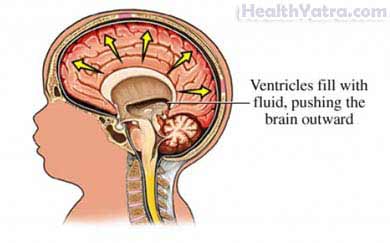تعريف
Hydrocephalus is too much fluid in the brain. The fluid is called cerebrospinal fluid (CSF). It is a clear fluid that normally surrounds both the spinal cord and the brain. You may be born with hydrocephalus or it develops after an injury or illness.

أسباب
Hydrocephalus occurs when:
- An excess of CSF is produced (rare)
- A blockage that doesn’t allow CSF to drain properly (more commonly)
These problems with the CSF may be caused by:
- أورام الدماغ
- Cancer in the cerebrospinal fluid (CSF)
- Swelling in the CSF (such as sarcoidosis)
- Cysts in the brain
- Malformations of the brain, such as:
- Dandy-Walker syndrome
- Arnold-Chiari malformation
- السنسنة المشقوقة
- Brain injuries
- Infections of the brain or the meninges can be caused by a number of agents including bacteria, mycobacteria, fungus, viruses, and parasites, such as:
- Encephalitis—inflammation of the brain
- Meningitis—inflammation of the membranes that cover the brain and spinal cord
- Problems with the blood vessel in the brain
- Bleeding into the brain or CSF space
عوامل الخطر
Risk factors for hydrocephalus include:
- Neural tube defects—problems with the development of the brain as a fetus
- Mother has infection during pregnancy, such as:
- فيروس مضخم للخلايا
- داء المقوسات
- Lymphocytic choriomeningitis virus
- حُماق
- النكاف
- Brain infections
- Malformations of the brain
- Brain injuries
- Brain hemorrhage
الأعراض
Symptoms depend on the severity of the hydrocephalus. The extra CSF puts pressure on the brain. Symptoms may start out mild and become more severe as CSF pressure increases.
قد تشمل الأعراض ما يلي:
- Headache (often worse when lying down or upon first awakening in the morning or with straining)
- Nausea / Vomiting
- Problems with balance
- صعوبة في المشي
- ضعف التنسيق
- سلس البول
- تغييرات الشخصية
- ارتباك
- مشاكل في الذاكرة
- Dementia in the elderly
- Coma and death
In babies, symptoms may include:
- Slow development
- Loss of developmental milestones—no longer able to do activities they once could do
- Bulging fontanelle (soft spot on the head)
- Large head circumference
التشخيص
سوف يسألك الطبيب عن الأعراض والتاريخ الطبي. اختبار فيزياء سوف يتم.
Tests to examine the brain may include:
- Computed tomography (CT) scan—a type of x-ray that uses a computer to make pictures of the inside of the brain
- Magnetic resonance imaging (MRI) scan—a test that uses magnetic waves to make pictures of the inside of the brain
- Ultrasound—a test that uses sound waves to examine the brain
العلاج
قد يشمل العلاج ما يلي:
- Shunt placement (ventriculoperitoneal shunt)—a shunt (a tube placed into the brain) allows excess CSF to drain into another area, usually the abdomen. Sometimes a temporary extraventricular drain (EVD) is placed.
- Third ventriculostomy—a hole is created in an area of the brain. It allows the CSF to flow out of the area where it is building up.
- Removal of the obstruction of CSF flow. For example: removal of tumor or cyst
- Lumbar puncture (spinal tap)—This involves the insertion of a needle between the back bones in the back to remove excess CSF.
- Medicines—In some cases, medicines, such as acetazolamide (Diamox) and furosemide (Lasix), may decrease the production of CSF.
- Other medicines such as steroids or mannitol may decrease swelling around lesions that are causing obstruction of CSF flow.
People who have risk factors for hydrocephalus should be carefully monitored. Immediate treatment might prevent long-term complications.
If you are diagnosed with hydrocephalus, follow your doctor’s instructions.
الوقاية
There are no known ways to prevent all cases of hydrocephalus. In general:
- Get regular prenatal care.
- Keep your child’s vaccines up to date.
- Protect yourself or your child from head injuries.
Certain infections in the mother during pregnancy can cause hydrocephalus in the baby. Examples of infections known to cause problems during pregnancy include:
- Toxoplasmosis—foodborne illness that may be prevented by:
- Carefully cook meat and vegetables.
- Correctly clean contaminated knives and cutting surfaces.
- Avoid handling cat litter, or wear gloves when cleaning the litter box.
- Cytomegalovirus (CMV)—talk to your doctor about identifying CMV in pregnancy
- Lymphocytic choriomeningitis virus (LCV) from pet rodents (mice, rats, hamsters)—avoid rodent contact during pregnancy
- Viruses that cause chickenpox or mumps—can be prevented with vaccinations
